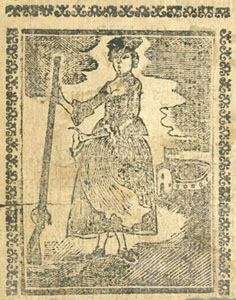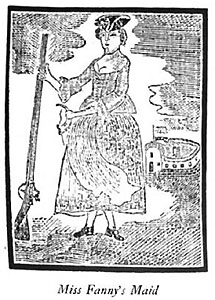Ray Raphael just described how an Advanced Placement exam in U.S. History asked students to analyze what this image of a musket-toting woman said about the Revolutionary War. The picture appeared on an undated broadside commenting on the war with a poem titled “A New Touch on the Times” by a “Daughter of Liberty, living in Marblehead.” That test question depended on the assumption that the image was created as part of that commentary.

Scholars have guessed that broadside was published in 1779 by Ezekiel Russell, a printer working out of Danvers, Massachusetts, during the war. He printed a lot of topical verse, much of it written by his wife Sarah or a young woman who lived with them.[1] However, the image was actually derived from an older woodcut—a common practice. The law and ethics of copyright were still in their infancy in the 1700s. Most printers felt that if they went to all the trouble of scraping a picture into a block of wood or type metal they were entitled to use the resulting cut, regardless of who had originally drawn that image.
The cut on the “New Touch on the Times” broadside is a mirror-image version of a picture that had appeared in Thomas’s New England Almanack…[for] 1775, issued by Boston printer Isaiah Thomas at the end of 1774. Both show a woman in a man’s cocked hat holding a firelock and powder horn in front of a fort flying the English flag. Since the first picture of that musket-toting woman predated the Revolutionary War, the image could not have been inspired by the social conditions brought about by the war.

Thomas used that cut to introduce “The Life and Adventures of a Female Soldier,” a long article (cribbed from a British source) about the military career of Hannah Snell (1723-1792) of London. Snell had disguised herself as a man and fought as a marine in the Royal Navy during King George’s War in the 1740s. She had carried a gun, though not while wearing women’s clothing as the picture showed; British portraits of Snell depicted her in a man’s uniform. But the image of a woman with both gown and gun nicely summed up the seeming paradox of a “Female Soldier.” Some historians view Thomas’s choice to reprint Snell’s story in late 1774 as a sign of growing militancy in New England just before the Revolutionary War began.
But Isaiah Thomas wasn’t the first printer to use that woodcut. Five years earlier, in 1770, Zechariah Fowle and Nathaniel Coverly of Boston issued parallel editions of the Narrative of the Captivity, Sufferings and Removes of Mrs. Mary Rowlandson. That was one of New England’s most popular “Indian captivity narratives,” first published in 1682. In the Fowle and Coverly editions, the musket-toting woman served as a portrait of Rowlandson—even though she never described herself picking up a gun.[2]

And Rowlandson’s Narrative wasn’t the first time Zechariah Fowle had used that woodcut, either. Back in 1762 he issued A New Book for Children, a series of moralizing tales copied from yet another British publication. In one story Miss Fanny Goodwill carelessly stays out later than she promised her mother. Her maid suggests she blame a friend for detaining her—but our virtuous heroine insists she must not tell a lie. The musket-toting woman serves as “Miss Fanny’s Maid.” The story never describes Fanny’s maid carrying a gun. Instead, it looks like Fowle had grabbed whatever cuts he already had in his shop to illustrate this book.

So who originally carved that musket-toting woman? It’s possible that she was the creation of Isaiah Thomas, who was indentured to Zechariah Fowle in 1755 at the age of six and worked for him for ten years before running off to Halifax. In later life Thomas recalled that he had carved about a hundred crude images for Fowle’s ballads.[3] After five years away from Boston, Thomas returned in 1770 and went into business with his old master to establish the Massachusetts Spy newspaper. A short time later, he again struck out on his own—evidently taking the musket-toting woman with him.
But what did that woman originally represent? One possibility is that she was meant to be Hannah Snell in an early Boston edition of her story that has not survived. In that case, the picture did originally show a woman who took up arms for the British Empire—an emblem of patriotism that a “Daughter of Liberty” might admire.
However, the iconography offers another possible origin, with an opposite meaning. Since the mid-1500s European printers had issued broadsides and pamphlets titled “The Folly of Man,” “The World Turn’d Upside-Down,” “The Comical Metamorphoses,” or some variation on those labels. These were collections of absurd images: a man pulling a donkey in a cart, a child whipping a parent, a cow butchering a man, or (after 1783) a balloon floating below its basket.[4]
One very common image in those “World Turn’d Upside-Down” collections showed a man sitting down to spin yarn or take care of a baby while a woman set off for war. Originally the woman had a sword, but by the eighteenth century she was carrying a musket and often putting on a man’s hat. Francis Bailey’s Continental Almanac for 1782 celebrated the American triumph at Yorktown with a similar cartoon titled “Cornwallis Turned Nurse, and His Mistress a Soldier.” It’s possible that sometime before 1762 Zechariah Fowle’s print shop produced its own version of that “World Turn’d Upside-Down” image.

Given that long tradition, we have to pay special attention to one of the poetic complaints in the “New Touch on the Times” broadside: “The world is now turn’d up-side down.” Perhaps the printer chose the musket-toting woman to illustrate that line, not the “Daughter of Liberty.” The image that came down to us as a picture of Mary Rowlandson, Hannah Snell, or a patriotic American woman might actually have been carved to signify total nonsense.
[1] Isaiah Thomas described Russell’s wife writing verses in the first edition of The History of Printing in America (Worcester: Isaiah Thomas, 1810), 1:367. However, he later amended this text to credit an unnamed “young woman who lived in Russell’s family,” and that change was published in The History of Printing in America, 2nd edition (Albany: Joel Munsell, 1874), 1:155. J. L. Bell, “The Mysteries of Ezekiel Russell’s Wife,” provides the name and particulars of Sarah Russell: http://boston1775.blogspot.com/2014/02/the-mysteries-of-ezekiel-russells-wife.html/.
[2] A 1773 edition of Mary Rowlandson’s narrative issued by John Boyle of Boston also featured a title-page picture of a woman with a gun. In fact, Boyle’s cut shows the woman aiming her musket at a line of hatchet-carrying Indians. Again, there was no such scene in the book. Those illustrations might indicate that New England readers of the 1770s wanted to see Mary Rowlandson fighting back against her enemies.







Recent Articles
That Audacious Paper: Jonathan Lind and Thomas Hutchinson Answer the Declaration of Independence
Supplying the Means: The Role of Robert Morris in the Yorktown Campaign
Revolution Road! JAR and Trucking Radio Legend Dave Nemo
Recent Comments
"Eleven Patriot Company Commanders..."
Was William Harris of Culpeper in the Battle of Great Bridge?
"The House at Penny..."
This is very interesting, Katie. I wasn't aware of any skirmishes in...
"Texas and the American..."
Mr. Villarreal I would like to talk to you about Tejanos who...